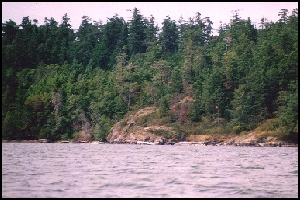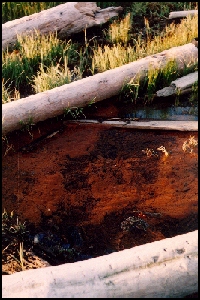 | ||||||
| Articles | Projects | Resume | Cartoons | Windsurfing | Paintings | Album |
Esquimalt Lagoon
State of the Ecosystem Report

Water Quality Analysis Project 1998
Waterose et. al.

Section 6. Hydrocarbons:

Figure 6.1 Hydrocarbons in the Lagoon
At several locations, substances that resembled oils (hydrocarbons), were observed leaching into the ponds and Esquimalt Lagoon. These are illustrated in Figure 6.1. Four sediment samples, including one duplicate, were collected and sent to a professional laboratory for analysis. The purpose of this was to determine if petroleum hydrocarbons were present, and in what quantity. The findings are discussed in the results and discussion section.
Hydrocarbons are organic compounds composed solely of carbon and hydrogen. They include aliphatic compounds in which carbon atoms form chains, and aromatic compounds, where the carbon atoms form stable rings. A large portion of anthropogenic hydrocarbons are introduced to ecosystems through the use of fossil fuels and associated products, such as lubricating oils, tars and asphalt (Papper, Gerba, and Brussean, 1996). Many hydrocarbons are carcinogenic, and present a danger if they enter the food chain. Many hydrocarbons are produced naturally through the decomposition of organic matter, as well as by certain plants, such as pine trees, creosote bushes and cattails.
Soil scientists have deduced that the recalcitrant remains of woody terrestrial plants make up a major portion of the natural organic matter in soils. Such materials also make up an important fraction of organic matter suspended in freshwater (Schwarzenbach, Gschwend & Imboden, 1993). Similarly, marine chemists believe that the natural organic matter, suspended in the oceans at sites far from land, consists of altered biomolecules such as amino acids, sugars, and triglycerides that have been linked together.
In some waterbodies, such as large lakes and estuaries, the natural organic material in sediments and in the water column appears to be derived from a variable mixture of terrestrial planktonic organism remains. These materials are composed of about forty to fifty per cent carbon by weight. However, some have nearly as many oxygen atoms as carbon included in their structures. Thus, they are not as polar as water, as they can only be involved in H-bonding at limited points on their structures. However, they are not as non-polar as hydrocarbons or chlorinated hydrocarbons because they do contain oxygen and nitrogen.
Such natural organic matter occurs in a broad spectrum of molecular sizes ranging from the smallest fulvic acids of approximately 1000 AMU to the huge complexes of solid kerogen. The important point is that when these natural organic constituents are associated with particles, and even when they remain suspended as non-settling particles called colloids in aqueous solution, they offer a relatively non-polar environment into which a hydrophobic compound may escape without undue competition with water (Schwarzenbach, Gschwend & Imboden, 1993).
To Section 7. Sample Procedure
Index:
- Introduction
- History and Land Use
- Geomorphology
- Nutrients and Coliforms
- Red Tides and Fish Kill
- Hydrocarbons
- Sample Procedure
- Analysis Procedure
- Results
- Discussion
- Future Study
- References
- Photo Album


 email Waterose
email Waterose
Please Sign My Guestbook
Please View My Guestbook

| Articles | Projects | Resume | Cartoons | Windsurfing | Paintings | Album |
 | ||||||